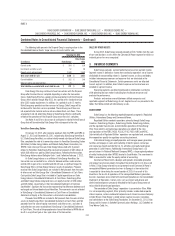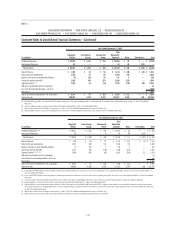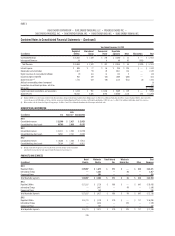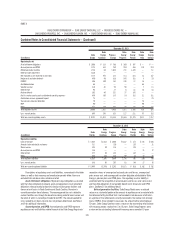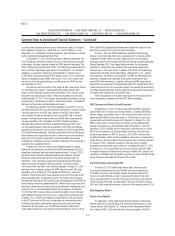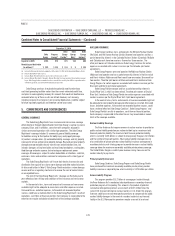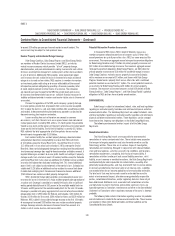Duke Energy 2014 Annual Report Download - page 141
Download and view the complete annual report
Please find page 141 of the 2014 Duke Energy annual report below. You can navigate through the pages in the report by either clicking on the pages listed below, or by using the keyword search tool below to find specific information within the annual report.
121
PART II
DUKE ENERGY CORPORATION • DUKE ENERGY CAROLINAS, LLC • PROGRESS ENERGY, INC. •
DUKE ENERGY PROGRESS, INC. • DUKE ENERGY FLORIDA, INC. • DUKE ENERGY OHIO, INC. • DUKE ENERGY INDIANA, INC.
Combined Notes to Consolidated Financial Statements – (Continued)
for retail purposes and over the longer of 10 years or the previously estimated
planned retirement date for wholesale purposes. Duke Energy Indiana earns a
return on the outstanding balances and the costs are included in rate base.
Debt fair value adjustment. Purchase accounting adjustment to restate
the carrying value of Progress Energy debt to fair value. Amount is amortized
over the life of the related debt.
Net regulatory asset related to income taxes. Regulatory assets
principally associated with the depreciation and recovery of AFUDC equity.
Amounts have no impact on rate base as regulatory assets are offset by deferred
tax liabilities. The recovery period is over the life of the associated assets.
Hedge costs and other deferrals. Amounts relate to unrealized gains
and losses on derivatives recorded as a regulatory asset or liability, respectively,
until the contracts are settled. The recovery period varies for these costs, and
currently extends to 2027.
DSM/EE. The recovery period varies for these costs, with some currently
unknown. Duke Energy Carolinas, Duke Energy Progress, and Duke Energy
Florida are required to pay interest on the outstanding liability balance. Duke
Energy Carolinas, Duke Energy Progress and Duke Energy Florida collect a return
on DSM/EE investments.
Grid Modernization. Represents deferred depreciation and operating
expenses as well as carrying costs on the portion of capital expenditures placed
in service but not yet refl ected in retail rates as plant in service. Recovery period
is generally one year for depreciation and operating expenses. Recovery for
post in-service carrying costs are over the life of the assets.
Vacation accrual. Generally recovered within one year.
Deferred fuel. Deferred fuel costs represent certain energy costs that
are recoverable or refundable as approved by the applicable regulatory body.
Duke Energy Florida amount includes capacity costs. Duke Energy Florida and
Duke Energy Ohio earn a return on under-recovered costs. Duke Energy Florida
and Duke Energy Ohio pay interest on over-recovered costs. Duke Energy
Carolinas and Duke Energy Progress pay interest on over-recovered costs in
North Carolina. Recovery period is generally over one year. Duke Energy Indiana
recovery period is quarterly.
Nuclear deferral. Includes (i) amounts related to levelizing nuclear plant
outage costs at Duke Energy Carolinas in North Carolina and South Carolina,
and Duke Energy Progress in North Carolina, which allows for the recognition of
nuclear outage expenses over the refueling cycle rather than when the outage
occurs, resulting in the deferral of operations and maintenance costs associated
with refueling and (ii) certain deferred preconstruction and carrying costs at
Duke Energy Florida as approved by the FPSC primarily associated with Levy,
currently expected to be recovered in revenues by the end of 2017.
Post in-service carrying costs and deferred operating expenses.
Represents deferred depreciation and operating expenses as well as carrying
costs on the portion of capital expenditures placed in service but not yet
refl ected in retail rates as plant in service. Duke Energy Carolinas, Duke Energy
Progress, Duke Energy Ohio and Duke Energy Indiana earn a return on the
outstanding balance. Duke Energy Florida earns a return at a reduced rate. For
Duke Energy Ohio and Duke Energy Indiana, some amounts are included in rate
base. Recovery is over various lives, and the latest recovery period is 2081.
Gasifi cation services agreement buyout. The IURC authorized Duke
Energy Indiana to recover costs incurred to buyout a gasifi cation services
agreement, including carrying costs through 2018.
Transmission expansion obligation. Represents transmission
expansion obligations related to Duke Energy Ohio’s withdrawal from
Midcontinent Independent System Operator, Inc. (MISO).
MGP. Represents remediation costs for former MGP sites. In November
2013, the PUCO approved recovery of these costs through 2018. Duke Energy Ohio
does not earn a return on these costs. See Note 5 for additional information.
Costs of removal. Represents funds received from customers to cover
the future removal of property, plant and equipment from retired or abandoned
sites as property is retired. Also includes certain deferred gains on NDTF
investments.
Amounts to be refunded to customers. Represents required rate
reductions to retail customers by the applicable regulatory body. The refund
period is through 2016 for Duke Energy Florida and through 2017 for Duke
Energy Indiana.
Storm reserve. Duke Energy Carolinas and Duke Energy Florida are
allowed to petition the PSCSC and FPSC, respectively, to seek recovery of named
storms. Funds are used to offset future incurred costs.
RESTRICTIONS ON THE ABILITY OF CERTAIN SUBSIDIARIES TO MAKE
DIVIDENDS, ADVANCES AND LOANS TO DUKE ENERGY
As a condition to the approval of merger transactions, the NCUC,
PSCSC, PUCO, KPSC and IURC imposed conditions on the ability of Duke
Energy Carolinas, Duke Energy Progress, Duke Energy Ohio, Duke Energy
Kentucky and Duke Energy Indiana to transfer funds to Duke Energy
through loans or advances, as well as restricted amounts available to pay
dividends to Duke Energy. Certain subsidiaries may transfer funds to Duke
Energy Corporation Holding Company (the parent) by obtaining approval
of the respective state regulatory commissions. These conditions imposed
restrictions on the ability of the public utility subsidiaries to pay cash
dividends as discussed below.
Duke Energy Progress and Duke Energy Florida also have restrictions
imposed by their fi rst mortgage bond indentures and Articles of Incorporation
which, in certain circumstances, limit their ability to make cash dividends
or distributions on common stock. Amounts restricted as a result of these
provisions were not material at December 31, 2014.
Additionally, certain other subsidiaries of Duke Energy have restrictions
on their ability to dividend, loan or advance funds to Duke Energy due to specifi c
legal or regulatory restrictions, including, but not limited to, minimum working
capital and tangible net worth requirements.
Duke Energy Carolinas
Duke Energy Carolinas must limit cumulative distributions subsequent to
mergers to (i) the amount of retained earnings on the day prior to the closing of
the mergers, plus (ii) any future earnings recorded.
Duke Energy Progress
Duke Energy Progress must limit cumulative distributions subsequent
to the merger between Duke Energy and Progress Energy to (i) the amount of
retained earnings on the day prior to the closing of the merger, plus (ii) any
future earnings recorded.
Duke Energy Ohio
Duke Energy Ohio will not declare and pay dividends out of capital or
unearned surplus without the prior authorization of the PUCO. Duke Energy Ohio
received FERC and PUCO approval to pay dividends from its equity accounts
that are refl ective of the amount that it would have in its retained earnings
account had push-down accounting for the Cinergy Corp. (Cinergy) merger not
been applied to Duke Energy Ohio’s balance sheet. The conditions include a
commitment from Duke Energy Ohio that equity, adjusted to remove the impacts
of push-down accounting, will not fall below 30 percent of total capital.





